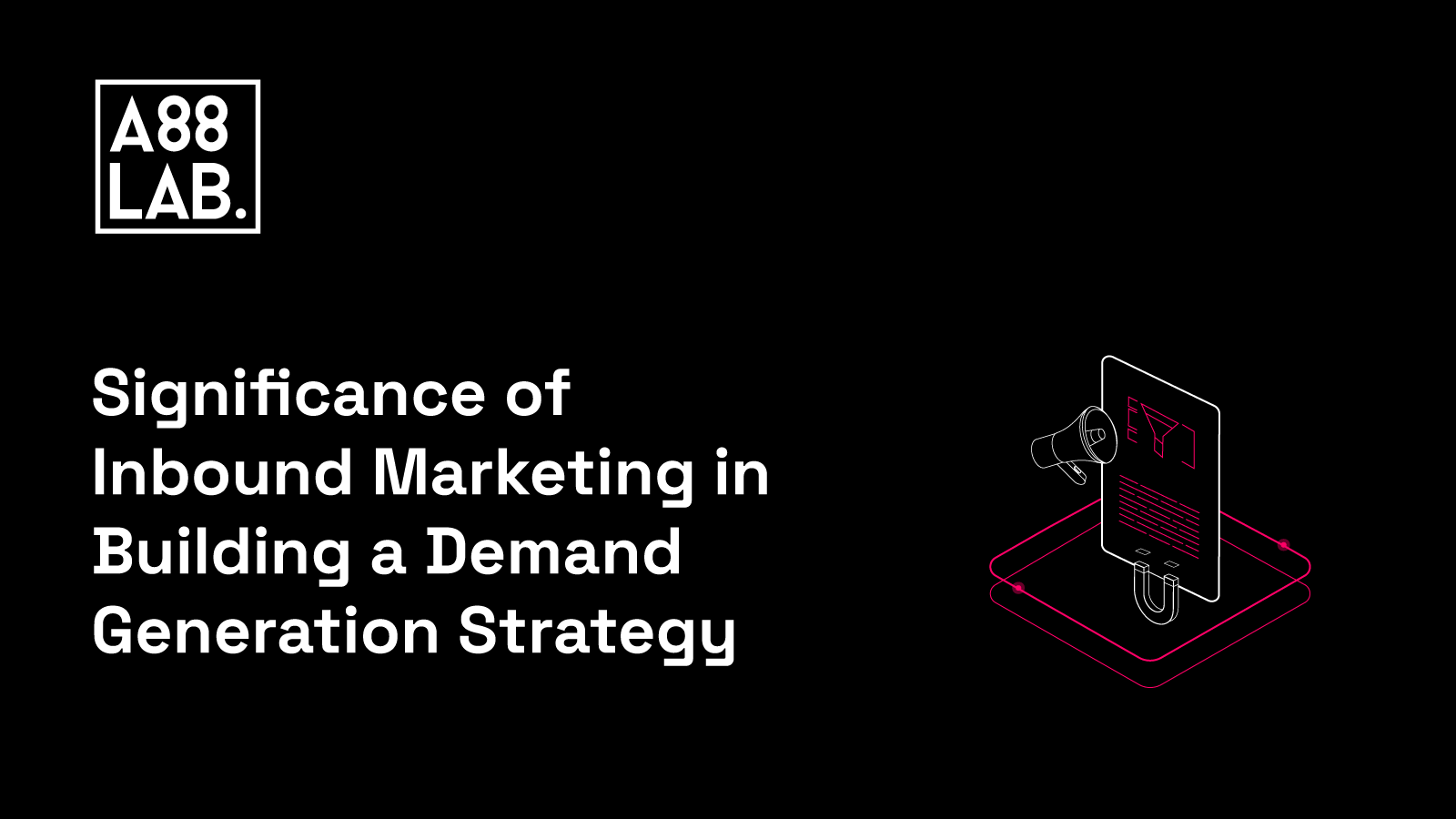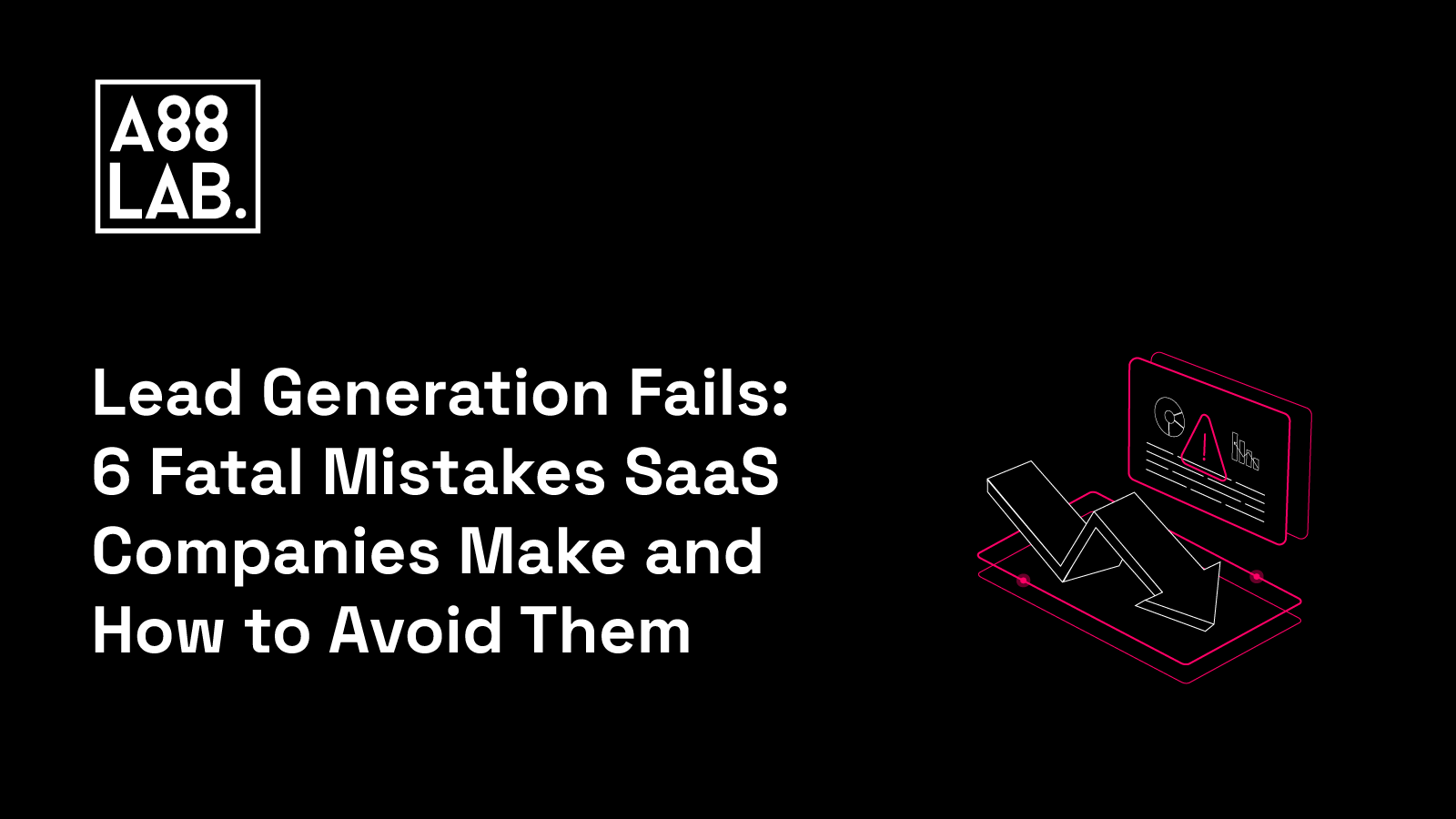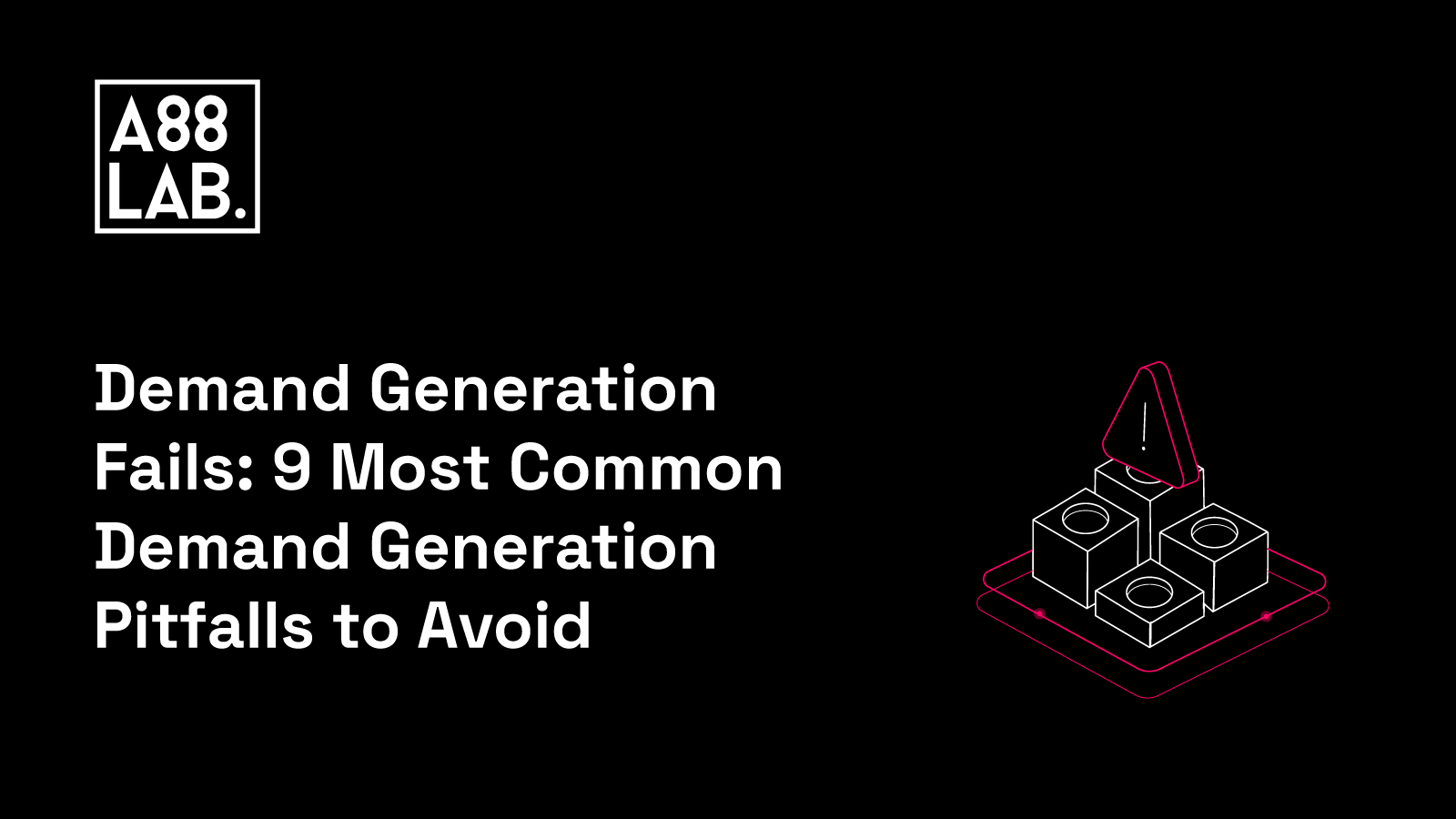Getting your SaaS to grow and scale requires building interest and awareness of your products in your target market. And one strategy that can help you with this is demand generation.
However, successfully implementing demand generation means implementing it in a way that will not overwhelm your audience. This means focusing on providing content that educates them and adds value. Which is where inbound marketing kicks in.
Your inbound marketing efforts' success determines the number of prospects you generate. That being said, now is a good time to mention that demand generation covers more than just inbound marketing. Even though inbound should be the center of it, there are plenty of other strategies, like sales enablement or ABM, that make up a successful demand gen strategy.
In this blog post, we'll talk about the essential role of demand generation in SaaS growth, the relationship between inbound marketing and demand generation, and talk about some inbound marketing strategies you can explore and use for your own demand gen plan.
Integration of Inbound Marketing and Demand Generation
B2B demand generation is a comprehensive strategy aimed at building long-term relationships between brands and customers through various marketing and sales approaches. As its name suggests, its primary objective is to create awareness, generate interest, and capture demand, ultimately speeding up the sales cycle.
Demand generation goes beyond single campaigns or strategies and extends throughout the entire buyer's journey. Its goal is not limited to acquiring new customers; instead, it focuses on connecting your brand with potential customers from the beginning of their journey all the way to the point of purchase and beyond.
Inbound marketing, on the other hand, involves creating valuable and engaging content to build brand awareness and cater to the needs of a specific target audience. So, while inbound is mostly marketing-centric, demand generation is more of a holistic approach that covers sales enablement, customer success, and other marketing-related activities.
Although, at first glance, demand generation and inbound marketing may seem like separate strategies, inbound marketing falls under the umbrella of demand generation. That means they are pretty closely aligned.
.webp?width=19201108&height=16220431&name=Inbound-Outbound-Activities-Demand-Generation_table%20(3).webp)
Inbound marketing supports demand generation by providing valuable content that educates potential customers to build their trust in the brand.
Unlike traditional outbound methods of marketing, where salespeople reach out to prospects, the inbound method focuses on providing relevant, educational content to prospects to nurture them through the stages of their buyer's journey: awareness, consideration, and decision.
And unlike demand generation that focuses on ungated content, inbound marketing often works with gated content, hoping to capture important lead information and nurture it further.
Inbound marketing and demand generation are critical components of a successful marketing strategy for SaaS. Both are crucial tactics that, when combined with other marketing techniques, can achieve outstanding results. Think of them as two sides of the same coin, different but still the same
Inbound Marketing - The Heart of Successful Demand Generation Strategy
Getting people interested in new products or services in emerging markets can be a challenge, especially for SaaS and B2B tech companies. Thankfully demand generation provides a way to raise awareness about the company's offerings before prospects go off the radar.
However, implementing it can be difficult as it involves educating the audience before they're ready to buy, which can sometimes turn into a slow process.
Many marketers find demand generation requires a lot of effort, with minimal returns. So in order to improve the success rate of their campaigns, they need to use inbound marketing techniques that can help them build relationships and educate potential customers through various valuable content.
How do you use inbound marketing to create demand? Here's a breakdown of the key steps:
- Identify Your Audience: Just like with every marketing strategy or tactic, you won't get far without getting to know the people you're trying to reach out to. Research the market and the target audience to make sure your campaigns are tailored specifically to their needs.
-
Craft Your Message: Develop a marketing message that addresses the goals and challenges of your audience. Make sure it is clear and concise and that it resonates with your ICP.
-
Build Early Traffic: Generate initial traffic to build your starting audience. Use organic and paid search, social media, and backlinks to drive people to your website.
-
Combine SEO and Inbound Marketing: Balance search engine optimization with inbound marketing strategies. Use tactics such as blogging, creating landing pages, and optimizing content for search to build brand visibility.
-
Test Keywords: Experiment with keywords in related markets and standard industry solutions. This will help you target the right audience and make sure your content is reaching potential customers.
-
Controlled Testing: Mitigate risks by conducting controlled tests to refine your approach. Analyze the data generated and fine-tune your strategies based on the results.
- Focus on the Attract Stage: In the inbound marketing process, demand generation starts with attracting audiences. Focus on that process by creating compelling content and then leveraging social media, advertising, and other strategies to draw in potential customers.
Although these steps can somewhat help us in building the initial demand generation strategy, to ensure success we also need to focus on the other stages of inbound marketing, such as nurturing and converting.
Nurturing is all about building relationships with potential customers by providing helpful advice and content that supports them in their buying process. This allows us to build trust and long-term relationships that increase the chance of successful conversions.
Finally, converting is when visitors become customers. Here, you need to use targeted offers and persuasive content to encourage prospects to take action. It's important to remember that the buying process is not a linear one and your nurturing and conversion tactics should reflect this.
Inbound Marketing and Lead Nurturing
As mentioned above, lead nurturing is the process of building relationships with potential customers by providing them with advice and content that will support them in their buying journey. The goal is to keep prospects engaged so they are more likely to make a purchase when they’re ready. This can be done through email campaigns, webinars, ebooks, whitepapers, etc.
To make sure your lead nurturing efforts are successful, always bring your focus back to the customer's needs. Typically, only a small portion of inbound leads are ready to make an immediate purchase, so you need to focus on helping them move down the sales funnel.
Despite the clear benefits of lead nurturing, marketers often find it challenging to develop an effective strategy. According to the 2019 Lead Nurturing & Acceleration Survey, 60% of respondents gave their nurture programs a failing grade. However, this also presents an opportunity for marketers to gain an advantage over their competition by being the ones to implement a more successful lead nurturing strategy.
Here are some effective tactics you can follow for successful lead nurturing:
-
Create content that targets your audience: By now, you probably identified your target audience and what their needs are, so use that information to create content that speaks to them. It should be tailored to the stage of the buying cycle they're in and should focus on solving customer pain points.
-
Nurture leads across multiple channels: Don't just send emails - different people like to be contacted in different ways. Consider using other channels such as text messaging, social media posts, or direct mail campaigns.
-
Use a mix of content and channels: To get the most out of your lead nurturing efforts, mix up content types and campaigns that will reach different people in different ways. Consider creating video tutorials, hosting webinars, offering discounts/coupons, or offering free trials to get people to engage with your brand.
-
Follow up promptly: When leads do engage with your content, make sure you follow up with them on time. This will help you build relationships and keep the conversation going.
-
Personalize your communication: Once you start following up with leads, make sure the messages you're sending are personalized. Adding in details that are relevant to them and going past the automated name or industry, as it goes a long way in helping to build relationships.
-
Prioritize leads with lead scoring: Lead scoring is essentially a way to rate prospects based on their engagement with your content. This will help you prioritize leads and determine which ones are ready to start the sales process.
Inbound Marketing and the Buyer Journey
The whole point of knowing the buyer journey is to use it in your marketing strategy and create content that speaks to prospects in different stages of the buying cycle. Every SaaS company aims to make customers aware of the problems or challenges they may face in their business operations and how the company’s products or services can help solve them.
The inbound approach prioritizes providing value to customers before asking for returns. By offering valuable resources and information, we can guide them toward solutions that will increase revenue, improve efficiency, boost productivity, or solve specific challenges they face.
This, of course, involves creating relevant content for the right audience and delivering it at the appropriate time.
Successfully implementing your inbound marketing when it comes to the buyer journey and generating demand requires following five simple principles:
Standardize: Make It Scalable
The marketing processes you create have to be consistent and repeatable. Your brand story needs to be told in a consistent, recognizable voice, and your product messages must be communicated clearly across all channels. Otherwise, your messaging won't resonate with your target audience, and inconsistency will make it hard to scale.
Contextualize: Make It Relevant
Buyer personas, pain points, journey stages... All that trouble we go through to create them, just to not use them while creating content. Each content piece you create must be tailored to a specific group and directly speak to their needs and interests.
Optimize: Make It Hit the Mark
It's often not enough to create great content. For it to have an impact, you need to make sure it reaches the right people and, ideally, at the right time. That means optimizing for SEO and improving your strategy based on data.
Personalize: Make It Special
Have you ever received an email that just starts with "dear" without even using your name? In marketing, we collect so much data about our buyers, yet we often forget to take advantage of it. Personalizing your messaging and delivering content that is tailored to each specific individual will have a huge impact on engagement and conversion rates. After all, no one likes to feel like a number targeted by a CRM.
Empathize: Make It Human
We all know what it's like to be on the receiving end of endless, cold marketing messages. That's why empathy should be at the core of any content you create. If your audience can't connect emotionally with your brand or message, you won't be able to foster any kind of relationship.
Automated processes and tools can help us reach more people and save time, but they are no substitute for authentic human connection. With demand generation, strive for the right balance between technology and humanity by creating content that speaks to your audience on a personal level.
By keeping these five elements in mind, your buyer journey can genuinely start to take shape. Start by listening to your customers and responding in kind—create content that is relevant, engaging, and tailored to their interests. Use data-driven insights to optimize for organic reach and personalize the experience as much as possible. Most importantly, keep it all human-centered so your buyers feel recognized and value your interactions.
4 Crucial Tactics to Make Your Inbound Marketing Work
Now that you understand what inbound marketing is and why it matters for generating demand let's look at how to make it work in practice. Here are four key things you should consider when creating your inbound marketing strategy.
Inbound Content Audit
Before creating new content for your inbound marketing strategy, take stock of what already exists. What's been working so far? What's no longer relevant to your target market? Which content topics have received the most engagement from prospects or customers?
Content audit includes all that, plus reviewing all the strategies you're using to drive traffic to your website, including search engine optimization (SEO), paid ads, and other methods. Track your current successes and failures and use them to build a comprehensive inbound marketing plan that suits your audience.
Multi-Variant Call To Actions
When marketers decide to A/B test, they often make a lot of changes to their website or landing pages and then measure which one is performing better. The problem with this is that it can be difficult to pinpoint exactly why one version was better than the other.
To get more granular insights into what's working and what isn't, consider using multi-variant calls to action (CTAs). Instead of changing everything at once, try altering only one element at a time.
By A/B testing your CTA buttons, from font and color to size and wording, you can quickly identify which changes are producing conversions. Apart from buttons, consider testing other forms of CTAs, such as:
-
Experiment with different email subject lines to determine which ones generate more attention from potential customers.
-
Test both shorter and longer email messages to see which ones appeal to people more.
-
Compare different versions of emails to identify which ones generate more sales or leads for your product.
-
Gather real-time feedback to improve your emails and make them more enticing to potential SaaS users.
-
Change placement and context of blog post CTAs to increase the click-through rate.
By implementing A/B testing strategies and using multi-variant calls to action, you will get a better understanding of what works and what doesn't when it comes to your inbound marketing efforts. You'll be able to quickly identify the winning content or pages and use them as a baseline for future tests.
Implementing a Lead Capture System and CRM
One of the most powerful things about inbound marketing is its ability to gather leads online. Implementing a lead capture system to your website will make your lead generation process automatic and much easier.
After you drive traffic to your website, whether that's from Google, LinkedIn, or some other source, the lead capture system does the work of moving a visitor from the prospect stage of the funnel to the lead stage.
The next step is to set up a CRM (Customer Relationship Management) system such as HubSpot. This will allow you to nurture leads, follow up with them, and understand customer behavior better. Through the use of automated processes and workflows, your team can quickly identify who's actively engaging with your brand and target them with content that's tailored to their needs.
Finally, integrating your CRM system with a marketing automation platform such as Marketo or Pardot will help you further optimize campaigns and segment leads into different buckets. You'll be able to create more personalized marketing experiences for each customer, leading to improved engagement and better conversion rates.
Don't forget to offer something valuable in return for their contact information, such as a whitepaper or case study. Other useful resources include webinars, whitepapers, newsletters, and infographics.
Lead Scoring and Tracking
Not all leads are created equal and should not be treated the same way. For example, a customer who's been on your website for more than 10 minutes and clicked on multiple pages is likely to be more engaged than someone who was only there for 10 seconds.
Each of these leads should be assigned a score based on their behavior, and according to Marketing Sherpa, SaaS companies that use lead scoring experience a 77% increase in lead generation ROI compared to those that don't.
So how do you do it? First, you must assign a point system that rates traits such as website visits, page views, and other activities. The criteria for lead scoring for SaaS companies may include other factors such as the company's size, the industry they are in, the features they are interested in, and their level of engagement with your marketing materials.
Marketing Qualified Leads for SaaS companies could be those that have visited your website multiple times, downloaded a whitepaper, or signed up for a free trial. Sales Qualified Leads could be those who have requested a demo or pricing information. Highly Qualified Leads could be those who have shown a strong interest in your product and have engaged with your sales team.
With a good lead scoring system in place, you can ensure that each lead is being treated appropriately and that your sales team is focusing on the right opportunities.
If your team lacks the necessary skills and expertise, consider seeking assistance from experienced partners.
Conclusion
Marketers can probably agree that inbound marketing is the way we would want customer acquisition to happen, but in reality, it’s often a mix of outbound and inbound that yields the best results for the overall demand generation of a company.
Gaining organic traction is a far more natural way to gain customers, but it takes time and effort. For example, it takes time for a blog post to get traction and for customers to become interested in what you have to offer.
However, don't let that discourage you from taking an inbound approach to demand generation. With the right tools, strategies, and tactics in place, you will gain the traction that will help you drive your demand generation efforts to success and, ultimately, help you grow your SaaS.
.png)


